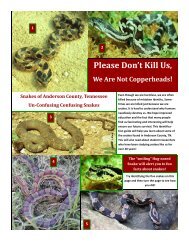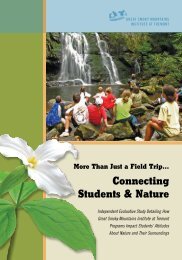Spring 2004 - Great Smoky Mountains Institute at Tremont
Spring 2004 - Great Smoky Mountains Institute at Tremont
Spring 2004 - Great Smoky Mountains Institute at Tremont
Create successful ePaper yourself
Turn your PDF publications into a flip-book with our unique Google optimized e-Paper software.
The newsletter of <strong>Gre<strong>at</strong></strong> <strong>Smoky</strong> <strong>Mountains</strong> <strong>Institute</strong> <strong>at</strong> <strong>Tremont</strong> • <strong>Spring</strong> <strong>2004</strong><br />
Around early February,<br />
folks <strong>at</strong> <strong>Tremont</strong> start to<br />
feel a strange feeling, sort of<br />
a tingling anticip<strong>at</strong>ion. It is<br />
the feeling th<strong>at</strong> we’ll soon<br />
be reunited with old<br />
friends, friends we haven’t<br />
seen or heard from in<br />
months.These friends signify<br />
the arrival of the wet<br />
and wonderful spring of the<br />
Smokies.After an unusually<br />
cold January, the sights<br />
and sounds of our friends<br />
are particularly welcoming<br />
this year.To bring the<br />
Smokies to you, our staff<br />
has collabor<strong>at</strong>ed to share a<br />
little about some of our<br />
favorite spring species, but<br />
we hope th<strong>at</strong> you can join<br />
us <strong>at</strong> <strong>Tremont</strong> this spring to<br />
experience them in person!<br />
Heralding <strong>Spring</strong><br />
The Black Chinned-Red Salamander (Pseudotriton ruber schencki) is one of my<br />
favorites and a somewh<strong>at</strong> rare surprise when turning over rocks in local<br />
streams. On early spring rainy nights however I have found these beauties<br />
wandering across the <strong>Tremont</strong> road. On several such occasions I’ve hiked the<br />
asphalt in rain gear with flashlight to see wh<strong>at</strong> has emerged.Wood Frogs<br />
(another favorite), Long-tailed Salamanders, and those stout red salamanders<br />
are often out in unusual abundance. Many amphibians move to breeding areas<br />
during this time of year, and their migr<strong>at</strong>ions make for gre<strong>at</strong> opportunities to<br />
see species th<strong>at</strong> are usually more reclusive. I also enjoy going out during the<br />
earliest rains a little further afield to visit a few secret places where the<br />
Spotted Salamanders g<strong>at</strong>her to lay their eggs.They are one of our larger salamanders<br />
and are quite striking, with yellow spots against a jet black slimy<br />
skin. On such trips, I am also thrilled by the trills and almost deafening calls<br />
continued on page 3<br />
KEN VOORHIS
Summers’ Salv<strong>at</strong>ion<br />
Becoming a part of the past, present, and future of summertime in Walker Valley<br />
It’s cold. And raining. And overcast and<br />
gray. It’s the glory of an early February<br />
afternoon here in Walker Valley.<br />
Now don’t get me wrong, it’s not th<strong>at</strong><br />
I’m complaining.There’s definitely something<br />
magical about being in the mountains<br />
on these midwinter days.The color of<br />
the river, the smells in the air, even the<br />
occasional column of sunlight brightening<br />
a spot on the mountainside. But there is<br />
something about days like these th<strong>at</strong> makes<br />
me sit here in the office, warming my<br />
hands on a cup of coffee and my toes in a<br />
pair of thick wool socks, and yearn for the<br />
nice warm days of summer.<br />
And somehow, I’m sure th<strong>at</strong> I am not the<br />
first person to sit in this valley and ward off<br />
a case of cabin fever by thinking forward to<br />
the sunny days of June and July. I have my<br />
memories of the past few years to entertain<br />
me, but I also wonder wh<strong>at</strong> summertime<br />
would have meant to all the past gener<strong>at</strong>ions<br />
of residents here in Walker Valley.<br />
Summer, 1904<br />
You wake up just before dawn and lay<br />
in the half-light of the loft for a few minutes<br />
listening to the stirrings of early<br />
morning just outside the cabin.The sounds<br />
of the fire being stoked downstairs lets you<br />
know th<strong>at</strong> you’re not the first to wake, so<br />
you slide out from bene<strong>at</strong>h your blanket,<br />
dress quickly, and climb down the ladder.<br />
As you sit and e<strong>at</strong> your morning meal,<br />
thoughts of the days chores fill your mind;<br />
tend to the chickens right off, then climb<br />
up on the barn roof and replace those<br />
shingles before the he<strong>at</strong> of the day, all this<br />
leading up to an afternoon working the<br />
corn out in the field. But you know th<strong>at</strong><br />
after all th<strong>at</strong> hard work, nothing in this<br />
world will feel better than a dip in the<br />
river before suppertime….<br />
Summer, 1926<br />
How amazing is this? You and forty other<br />
Girl Scouts are living in the middle of the<br />
<strong>Gre<strong>at</strong></strong> <strong>Smoky</strong> Mountain wilderness for two<br />
whole weeks. Camp Margaret Townsend,<br />
named after th<strong>at</strong> wonderful woman who<br />
asked her husband not to log this part of<br />
the valley so girls like you could spend your<br />
Adam Barnes<br />
summers here.You’ve already been here for<br />
a week, spending your days being guided<br />
along the trails by some of the old loggers,<br />
and your evenings singing songs around the<br />
campfire.And this year has been even better<br />
than last, since they dammed up the river<br />
next to our island and gave us a gorgeous<br />
new pool to swim in….<br />
Summer, 1971<br />
For being an experiment, this idea of a<br />
Youth Conserv<strong>at</strong>ion Corps sure seems like a<br />
good one to you. Not only have you gotten<br />
to spend the last 6 weeks <strong>at</strong> the Maryville<br />
College Environmental Educ<strong>at</strong>ion Center <strong>at</strong><br />
<strong>Tremont</strong>, but you’ve met all kinds of new<br />
people as well.There were those park rangers<br />
who took you out to inspect and clean up<br />
campsites, the folks who helped your crew<br />
rebuild one and a half miles of the famous<br />
Appalachian Trail, even a visit by Lady Bird<br />
Johnson, the wife of the president, to see<br />
how the YCC was working.And how gre<strong>at</strong><br />
were those days spent with the fisheries crew<br />
up to our waists in the cool w<strong>at</strong>er doing a<br />
stream survey and stocking fish….<br />
Summer, 2003<br />
You’re sitting in the pavilion waiting for<br />
the cookout to begin.As much as you’re<br />
looking forward to a big ol’ hamburger<br />
grilled by the <strong>Tremont</strong> kitchen staff, you<br />
know better than to e<strong>at</strong> too much right<br />
before the all-camp, boys versus girls<br />
Capture the Flag game coming up. Last<br />
year the girls won, so you and the other<br />
boys have been working on your str<strong>at</strong>egy<br />
all week during siesta time in the lodge.<br />
And after the big game, it’ll be time for the<br />
campfire. If it’s anything like the one the<br />
first night, you know th<strong>at</strong> the counselors<br />
have come up with some hilarious entertainment<br />
to share. Sitting there, you can’t<br />
believe you still have energy for all this<br />
after spending the entire day hiking eight<br />
miles in the mountains. But th<strong>at</strong> jump in<br />
the swimming hole when you got back<br />
made every step of the journey worth it….<br />
Well, I guess th<strong>at</strong> plenty of good memories<br />
have come out of our little valley over<br />
the years.And while it is important and<br />
Walker Valley Reflections 2<br />
Summer Camp Is Coming!<br />
You’ve thought about it, longed for it, dreamed<br />
about it during the dark days of midwinter. Now<br />
it’s time to do it. Sign your child up for a week<br />
of summer camp in the <strong>Gre<strong>at</strong></strong> <strong>Smoky</strong> <strong>Mountains</strong>!<br />
• Discovery Camp is one of our longest running<br />
programs for children ages 9-12. Kids get<br />
to explore n<strong>at</strong>ure, learning about plants and<br />
birds, frogs and snakes. There’s swimming in the<br />
river daily, plus a hiking adventure in the wilderness,<br />
and even a night’s campout in the woods.<br />
• Wilderness Adventure Camp is a 3 night/<br />
4 day backcountry excursion for teenagers<br />
who may have never backpacked before and<br />
want to see wh<strong>at</strong> it’s all about. Quite a few<br />
campers return summer after summer as well.<br />
• Teen High Adventure, a 6 night/7 day trek<br />
th<strong>at</strong> will likely include a day whitew<strong>at</strong>er rafting,<br />
is also for teenagers. Teen High Adventure<br />
is our premiere backpacking offering, designed<br />
to give teenagers a rewarding experience<br />
growing in the areas of backcountry skills,<br />
n<strong>at</strong>ure appreci<strong>at</strong>ion, and personal development.<br />
• Field Ecology Adventure (formerly known<br />
as Teen Science Camp) gives teenagers ages<br />
13-17 the opportunity of working with and as<br />
real scientists. Past campers have studied<br />
salamanders, insects, birds, and plants indepth.<br />
Climb a mountain, ford a river, and do<br />
real science.<br />
• <strong>Smoky</strong> Mountain N<strong>at</strong>uralist Expeditions<br />
gives kids ages 12-14 the opportunity to<br />
immerse themselves in a ten-day field of study<br />
learning about amphibians, black bears, forest<br />
ecology, or primitive skills. This is deep immersion,<br />
in contrast with the average park visitor,<br />
whose windshield experience motoring through<br />
the mountains hardly scrapes the surface.<br />
Expedition N<strong>at</strong>uralists will get to explore areas<br />
all over the Park, interact with professional land<br />
and wildlife managers, and gaze into the glowing<br />
embers of an evening campfire after an<br />
afternoon spent swimming in the Middle Prong.<br />
This unique program is truly one-of-a-kind.<br />
If you wish to see wh<strong>at</strong> a week <strong>at</strong> one of<br />
<strong>Tremont</strong>’s summertime youth programs looks<br />
like, click on our website <strong>at</strong> www.gsmit.org for<br />
a sample weekly schedule. These programs fill<br />
quickly, so sign your child up soon. We look<br />
forward to meeting you and spending the summer<br />
with your child! —Jeremy Lloyd<br />
impressive to recognize the changes th<strong>at</strong><br />
have happened to the mountains and its<br />
people over the years, it’s still good to know<br />
th<strong>at</strong> some things never change. Looking forward,<br />
who knows wh<strong>at</strong> memories will be<br />
made during the <strong>2004</strong> Summer Camps th<strong>at</strong><br />
will help get me through February next<br />
year. But no m<strong>at</strong>ter wh<strong>at</strong>, it feels good<br />
knowing th<strong>at</strong> I will become a part of the<br />
next piece of history woven into this place.
Heralding <strong>Spring</strong><br />
continued from page 1<br />
of <strong>Spring</strong> Peepers and Chorus Frogs.The<br />
amphibians also come out long before the<br />
wildflowers, so to me are some of the first<br />
signs th<strong>at</strong> spring is around the corner.<br />
—Ken Voorhis<br />
If you like spring wildflowers, there is no<br />
better place to be than the <strong>Gre<strong>at</strong></strong> <strong>Smoky</strong><br />
<strong>Mountains</strong> N<strong>at</strong>ional Park. Of all the amazing<br />
wildflowers th<strong>at</strong> I look forward to seeing,<br />
Bloodroot, Sanguinaria canadensis, is my<br />
favorite.This member of the poppy family<br />
is also known as Red Puccoon, Indian Paint<br />
or Tetterroot.The common name<br />
“Bloodroot” comes from the red juices in<br />
the root of the plant. It was used by N<strong>at</strong>ive<br />
Americans as a dye for fabrics and paints.<br />
Bloodroot contains sanguinarine, a chemical<br />
with akaloid properties th<strong>at</strong> has been used<br />
for antiseptic, anesthetic and anti-cancer<br />
tre<strong>at</strong>ments.The common name “Tetterroot”<br />
refers to the tre<strong>at</strong>ment of fungal infections,<br />
ringworm, and warts. It is commercially<br />
used in toothpastes and mouthwashes as it<br />
inhibits dental plaque.Although there are<br />
many medicinal uses for Bloodroot, this<br />
plant is toxic and should not be ingested.<br />
This flower has 8-10 white petals, surrounding<br />
golden stamen.The kidneyshaped<br />
leaf is unique and <strong>at</strong>tractive, sticking<br />
around long after the flower and seed capsule<br />
are gone. Look for Bloodroot from<br />
mid-March to April when it blooms here in<br />
Walker Valley, especially along the West<br />
Prong Trail. —Jaimie M<strong>at</strong>zko<br />
Wh<strong>at</strong> represents spring more than butterflies?<br />
Most butterflies overwinter in the<br />
egg, c<strong>at</strong>erpillar, or chrysalis stage, so we don’t<br />
see the adult butterflies on the wing until the<br />
we<strong>at</strong>her warms and they complete their life<br />
cycle. But a few butterflies, particularly those<br />
in the genus Nymphalis, overwinter as adults.<br />
It’s ne<strong>at</strong> to hike in winter and think about<br />
butterflies holed up in cracks and crevices<br />
around you. For this reason, the Mourningcloak<br />
(Nymphalis antiopa) is usually the first<br />
butterfly we observe in Walker Valley each<br />
spring, sometimes even coming out on<br />
warm, sunny days in early February. Adult<br />
Mourningcloaks prefer to e<strong>at</strong> tree sap and<br />
rotting fruit, while their spiny, red-and-black<br />
larvae feed in large groups on willow, elm,<br />
and other trees. Keep an eye out for<br />
Mourningcloaks where you are, too. They<br />
can be found in forests, suburbs, and even<br />
cities all across the US. —Michelle Prysby<br />
Many of the 200 or so bird species th<strong>at</strong><br />
have been recorded in <strong>Gre<strong>at</strong></strong> <strong>Smoky</strong><br />
<strong>Mountains</strong> N<strong>at</strong>ional Park are neotropical<br />
migrants.They breed here in the spring and<br />
summer, and migr<strong>at</strong>e to Central or even<br />
South America for the winter. Since few<br />
northern birds migr<strong>at</strong>e here for winter, an<br />
avid birdw<strong>at</strong>cher is always ready for spring.<br />
The aptly-named Pine Warbler (Dendroica<br />
pinus) is often among the first to arrive,<br />
since some of them winter as far north as<br />
the Gulf Coast.They nest in pine trees, and<br />
switch from e<strong>at</strong>ing insects to pine and other<br />
seeds in cold months. It is unusual to see a<br />
Pine Warbler away from a conifer for long.<br />
Sometime in early February, start listening<br />
for the loose, slow trill th<strong>at</strong> announces one<br />
of the bigger warblers in the area. Its yellow<br />
head, breast, abdomen, flanks and upper<br />
back are distinctive with the 2 large white<br />
wing bars, dark line before the eye and large<br />
(for a warbler) bill. —Charlie Muise<br />
The Eastern Fence Lizard (Sceloporous undul<strong>at</strong>us)<br />
is one of the first reptiles we see in<br />
Walker Valley each spring. It prefers sunny<br />
loc<strong>at</strong>ions and can be found resting on rotting<br />
logs and in open woodlands throughout the<br />
low and middle altitudes in the Smokies.<br />
While hiking in Walker Valley along the<br />
Lumber Ridge and Spruce Fl<strong>at</strong> Falls trail, keep<br />
an eye out for these gray and brown lizards<br />
with dark markings.The males have bluish<br />
p<strong>at</strong>ches on each side of the belly and thro<strong>at</strong>.<br />
Females lay 6-10 eggs in the l<strong>at</strong>e spring th<strong>at</strong><br />
h<strong>at</strong>ch in mid-summer.The earliest recorded<br />
sighting of the Eastern Fence Lizard in Walker<br />
Valley is January 23, and usually is seen by<br />
March 1.You may see one sunning itself while<br />
looking for a tasty snack consisting of spiders,<br />
centipedes, snails or beetles. —Jen Martin<br />
My favorite spring species is the Eastern<br />
Redbud or Judas tree (Cercis canadensis).<br />
The E. Redbud, in the Pea family, is a small<br />
tree with a rounded crown and maximum<br />
height of 40-50 feet.Wh<strong>at</strong> makes it my<br />
favorite are the beautiful magenta-colored<br />
flowers th<strong>at</strong> appear in clusters just before the<br />
heart-shaped leaves. Here in Walker Valley, the<br />
redbud blooms typically in l<strong>at</strong>e March, but<br />
has been seen as early as March 18 and as l<strong>at</strong>e<br />
as April 11.This tree is most commonly<br />
found in limestone areas below 2,200 feet,<br />
such as Cades Cove and many other places<br />
adjacent to the park.This tree has become an<br />
important ornamental species due to its<br />
showy flowers and small size.The flowers of<br />
the redbud can be e<strong>at</strong>en and are especially<br />
Walker Valley Reflections 3<br />
nice on a salad.The inner bark has been<br />
found to be highly astringent, and is commonly<br />
used as a folk remedy for stomach<br />
ailments.—Michael M<strong>at</strong>zko<br />
The first few weeks in April are when a little<br />
bit of sneaky magic occurs in our<br />
forests. During th<strong>at</strong> time, the trees begin to<br />
leaf and the woods begin to “green-up.” I<br />
eagerly anticip<strong>at</strong>e the<br />
greening-up time<br />
since it brings with it<br />
a succession of colors<br />
th<strong>at</strong> change daily.The<br />
first green leaves on<br />
the scene come from<br />
the random bursts of<br />
the emerald compound<br />
leaves of<br />
Yellow Buckeye.<br />
Soon, from the millions<br />
of tiny first<br />
leaves dotting the<br />
mountainsides, we see<br />
a haze of incredibly<br />
fresh, cool spring<br />
green.As the leaves<br />
grow, they begin to<br />
fill in the nooks and<br />
crannies, obscuring<br />
our view and cre<strong>at</strong>ing<br />
the “wall of green”<br />
which explorers of<br />
the Park know so<br />
well. By May, the<br />
fresh, lively greens of<br />
early spring have aged<br />
A few staff recommend<strong>at</strong>ions<br />
for field guides and<br />
references:<br />
• Amphibians and<br />
Reptiles of <strong>Gre<strong>at</strong></strong> <strong>Smoky</strong><br />
<strong>Mountains</strong> N<strong>at</strong>ional Park<br />
by James E. Huheey and<br />
Arthur Stupka<br />
• Peterson Field Guide,<br />
Eastern/Central<br />
Medicinal Plants<br />
by Steven Foster and<br />
James Duke<br />
• Wild Roots by<br />
Doug Elliot<br />
• Trees, Shrubs, and<br />
Woody Vines of <strong>Gre<strong>at</strong></strong><br />
<strong>Smoky</strong> <strong>Mountains</strong><br />
N<strong>at</strong>ional Park by<br />
Arthur Stupka<br />
• Butterflies Through<br />
Binoculars: The East<br />
by Jeffrey Glassberg<br />
• Wildflowers of the<br />
Smokies by Peter White<br />
to a more deep somber color as they set<br />
about the business of competing with their<br />
neighbors for sunlight.This subtle process of<br />
change and growth tempts me to w<strong>at</strong>ch<br />
every second so th<strong>at</strong> I miss none of its<br />
magic. —Amber Parker<br />
Ialways know th<strong>at</strong> spring is officially here<br />
when, after a quiet winter season, the park<br />
once again begins to fill with people.And<br />
every year, this return seems to be led by a<br />
group of one of the most interesting harbingers<br />
of springtime, the College <strong>Spring</strong> Breaker.<br />
The warm days and cool nights of mid-<br />
March triggers a huge migr<strong>at</strong>ion of subspecies<br />
of <strong>Spring</strong> Breakers from all over the<br />
United St<strong>at</strong>es, in particular, it seems, the<br />
Midwest. Many wind their way to Eastern<br />
Tennessee, while a few individuals find their<br />
journey’s end here <strong>at</strong> <strong>Tremont</strong>. Note is<br />
taken as they prepare to disperse towards<br />
continued on page 4
Heralding <strong>Spring</strong><br />
continued from page 3<br />
their ultim<strong>at</strong>e destin<strong>at</strong>ion, a backcountry<br />
campsite.Their packs are filled with gear,<br />
their legs with bravado, and their minds<br />
with dreams of adventure. Many disappear<br />
into the cove hardwood, where they are seldom<br />
seen or heard from for days <strong>at</strong> a time.<br />
But then, all <strong>at</strong> once, the first good rain<br />
drives them from their temporary woodland<br />
habit<strong>at</strong>s back into the arms of civiliz<strong>at</strong>ion.<br />
We see large groups of them huddled<br />
between the cover of cars trying desper<strong>at</strong>ely<br />
to light a stove on which to cook 2 cans of<br />
baked beans and a pot of mac and cheese.<br />
There are sleeping bags strewn about the<br />
parking lot in the early morning hours.<br />
Some are even bold enough to ask for directions<br />
to the nearest motel.After a few weeks<br />
of this convergence of life, the frenzy dies<br />
down, the individuals return to their n<strong>at</strong>ural<br />
habit<strong>at</strong>, and the forest waits for th<strong>at</strong> f<strong>at</strong>eful<br />
day in June, when school lets out for the<br />
summer. —Adam Barnes<br />
Successful Arts Curriculum Workshop<br />
On January 23-25, an extraordinary group of people<br />
came together <strong>at</strong> <strong>Tremont</strong> for a unique event. With<br />
help from the Tennessee Arts Commission, we hosted<br />
a diverse array of people—educ<strong>at</strong>ors and arts professionals—for<br />
the purpose of cre<strong>at</strong>ing a new artsbased<br />
curriculum for <strong>Tremont</strong>’s school programs.<br />
Tent<strong>at</strong>ively called Exploring the Smokies Through the<br />
Arts, this program will do just th<strong>at</strong>—use the arts more<br />
fully to connect children with n<strong>at</strong>ure.<br />
Starting from scr<strong>at</strong>ch is not easy, and we had to<br />
take into account our limit<strong>at</strong>ions. For instance,<br />
because we’re loc<strong>at</strong>ed inside a N<strong>at</strong>ional Park, we<br />
cannot reconstruct an old settler’s cabin or traditional<br />
Cherokee dwelling on the <strong>Tremont</strong> campus. We<br />
began to see these limit<strong>at</strong>ions as strengths because,<br />
by virtue of being loc<strong>at</strong>ed in a N<strong>at</strong>ional Park, an arts<br />
program <strong>at</strong> <strong>Tremont</strong> would truly be one-of-a-kind.<br />
We continue to hammer out a lesson manual<br />
th<strong>at</strong> will glue it all together, and in the meantime,<br />
we will continue spreading the word about this<br />
exciting project. If you are a school teacher and<br />
want to learn more, you can even put your two<br />
cents in on the cre<strong>at</strong>ive process! Call (865) 448-<br />
6709 or email me <strong>at</strong> Jeremy@gsmit.org.<br />
Other big plans for the arts <strong>at</strong> <strong>Tremont</strong> loom in<br />
the future, and for now we’re dreaming big: an<br />
arts-based curriculum for high school, college and<br />
adult groups…a concert and lecture series…and<br />
even an Artist-in-Residence program. Helped by<br />
the Clayton Family Found<strong>at</strong>ion, which recently<br />
awarded <strong>Tremont</strong> with a $5000 grant, we hope to<br />
make a portion of this a reality soon. Stay tuned!<br />
—Jeremy Lloyd<br />
The House Th<strong>at</strong> Jack Built<br />
Those of you who live to climb mountains<br />
have probably been asked,“Why<br />
do you do it?” I’m sure the answer is<br />
always the same—“If you have to ask, you<br />
probably wouldn’t understand.” At<br />
<strong>Tremont</strong>, we like to provide opportunities<br />
for people to not only stand on top of the<br />
mountain, but to learn about the flora and<br />
fauna, the history of the mountain and stories<br />
th<strong>at</strong> it has to share. It’s one thing to<br />
climb up a mountain and back the same<br />
day, returning before dusk. It’s quite another<br />
to stand <strong>at</strong>op as you w<strong>at</strong>ch the colors of<br />
the sunset give way to the darkness and<br />
the stars, knowing you will be there to<br />
w<strong>at</strong>ch it rise again, after sleeping <strong>at</strong> over<br />
6,500 feet. Mt. Le Conte is one of the few<br />
places to have this experience.There is a<br />
lodge on Mt. Le Conte th<strong>at</strong> <strong>at</strong>tracts hikers<br />
from all over because of the good food,<br />
rustic <strong>at</strong>mosphere and of course, the loc<strong>at</strong>ion.<br />
Although high country ecology and<br />
science research are the topics of our Mt.<br />
Le Conte hikes this spring, summer and<br />
fall, there are so many stories th<strong>at</strong> this old<br />
mountain holds. As one explores Mount<br />
Le Conte, it’s hard not to wonder… “Who<br />
were some of the early explorers? Wh<strong>at</strong><br />
were their stories?”<br />
According to A N<strong>at</strong>ural History of Mount<br />
Le Conte, by Kenneth Wise and Ron<br />
Peterson, Mount Le Conte was named for<br />
Walker Valley Reflections 4<br />
Stories come alive on Mount Le Conte<br />
by Jaimie M<strong>at</strong>zko<br />
Professor John Le Conte of South Carolina<br />
College, who never climbed this mountain.<br />
Sam Buckley and Thomas Clingman<br />
had honored Le Conte because of his help<br />
in measuring the elev<strong>at</strong>ion of <strong>Smoky</strong><br />
Dome, now known as Clingmans Dome.<br />
Although elev<strong>at</strong>ion measurements and<br />
explor<strong>at</strong>ions of Mt. Le Conte took place in<br />
the 1850s, it wasn’t until the 1920s th<strong>at</strong><br />
visits on the mountain became more frequent.<br />
Paul Adams first climbed Le Conte<br />
in 1918, when his family moved to<br />
Knoxville. He was an enthusiastic n<strong>at</strong>uralist<br />
and hiker, spending all his free time finding<br />
new adventures in the <strong>Gre<strong>at</strong></strong> Smokies. In<br />
1924, his knowledge and experiences<br />
would soon prove important as Adams was<br />
asked to join the <strong>Gre<strong>at</strong></strong> <strong>Smoky</strong> Mountain<br />
Conserv<strong>at</strong>ion Associ<strong>at</strong>ion by Colonel<br />
David Chapman. This group was organized<br />
to promote the idea of the <strong>Gre<strong>at</strong></strong><br />
<strong>Smoky</strong> <strong>Mountains</strong> becoming a N<strong>at</strong>ional<br />
Park. In August of th<strong>at</strong> year, Adams would<br />
help guide the first Park Commission trip<br />
to Le Conte.This was a difficult trip; they<br />
did not have the maintained trails we use<br />
today. On the descent, they were one of<br />
the first known groups to travel from the<br />
top of Mount Le Conte to Alum Cave<br />
Bluffs. In Adams’ writings he says,“We<br />
rested fairly often, trying to pick out the<br />
good points for our stops…This took a<br />
NATIONAL PARK SERVICE
long time. But the bones and peace of<br />
mind of our visitors were precious.We<br />
wanted them to see the beauty and<br />
ruggedness of our mountains, so th<strong>at</strong> they<br />
would recommend the establishment of<br />
the Park.” This trip led to Chapman offering<br />
Adams the opportunity to establish a<br />
permanent camp. Adams loc<strong>at</strong>ed a w<strong>at</strong>er<br />
source <strong>at</strong>op the mountain, now known as<br />
the Basin <strong>Spring</strong>.With the permission of<br />
the Champion Fibre Co., the logging<br />
company th<strong>at</strong> owned the mountain, he<br />
established a camp to the west of where Le<br />
Conte Lodge now stands. He constructed<br />
a fifteen-by-twenty foot cabin of notched<br />
spruce and fir logs, using moss and clay for<br />
the chinking. Adams kept a journal of his<br />
discoveries and adventures <strong>at</strong> his camp,<br />
with his faithful canine companion,<br />
Cumberland Jack, in a book titled Mount<br />
Le Conte.<br />
On May 10, 1926, Jack Huff and Will<br />
Ramsay took over management, building a<br />
larger cabin, thirty by twenty-four feet of<br />
all balsam wood, or Fraser Fir.There were<br />
From <strong>Tremont</strong> to Elkmont<br />
These mountains hold so many interesting<br />
stories, we’ll never know them<br />
all. And sadly many tales are being<br />
lost as people who know them carry<br />
them to their graves. Th<strong>at</strong>’s why it’s<br />
so important to tell these mountain<br />
stories and keep them alive. Each<br />
pre-park community was<br />
rich with legend and<br />
lore, and Elkmont is no<br />
exception. With a little<br />
imagin<strong>at</strong>ion and guidance,<br />
today’s campground<br />
reverts back to<br />
the old logging town<br />
with trains passing<br />
through. The ghost town<br />
of forsaken cabins<br />
comes alive when we<br />
learn about the people who lived<br />
there. And of course the cemeteries<br />
hold their own stories of the almost<br />
forgotten people who are buried<br />
there.<br />
Those of you who have come to<br />
<strong>Tremont</strong> have probably visited the<br />
Walker Cemetery where little Vannie<br />
Cook was buried after a burning tree<br />
fell on her. Now I’d like to tell you<br />
the rest of the story. Vannie’s f<strong>at</strong>her,<br />
sixteen upper and lower bunks made of fir<br />
branches covered with blankets.The<br />
boarded roof was w<strong>at</strong>erproofed with tarpaper<br />
and gravel, and the fireplace was built<br />
of rocks <strong>at</strong> the opposite end of the door.<br />
This cabin was known as “The house th<strong>at</strong><br />
Jack built.”The most amazing story I have<br />
read of Jack Huff was when he carried his<br />
mother up to the top of Mount Le Conte.<br />
Her health was failing and all she wanted<br />
to do was w<strong>at</strong>ch the sunrise <strong>at</strong> Myrtle<br />
Point before she died. Jack built a rocking<br />
chair th<strong>at</strong> he could strap on his back,<br />
specifically designed to carry her to the<br />
top. Jack took only a few breaks to let her<br />
rest. He claimed she was the only one to<br />
ever climb Mount Le Conte backwards!<br />
Wh<strong>at</strong> a devoted son! Huff married his<br />
wife, Pauline in 1934 <strong>at</strong> Myrtle Point.<br />
They managed the Lodge until 1960.<br />
Although there have been many improvements<br />
and reconstruction since the “House<br />
th<strong>at</strong> Jack Built,” the lodging is still very<br />
rustic and now includes a dining hall,<br />
recre<strong>at</strong>ion hall, several small cabins, and<br />
Sam Cook, left Walker Valley and<br />
moved his family across Meigs<br />
Mountain to Jakes Creek, above<br />
Elkmont. His remaining daughter,<br />
Eva, l<strong>at</strong>er married Steve Ownby, who<br />
was from one of Elkmont’s original<br />
pioneer families. As a wedding present,<br />
Sam bought a nearby cabin for<br />
the newlyweds. This cabin, built in<br />
the mid-1800s, was<br />
l<strong>at</strong>er bought by Frank<br />
Avent for $200 and,<br />
beginning in 1919, was<br />
used by Mayna Treanor<br />
Avent, one of<br />
Tennessee’s most<br />
esteemed artists. But I’m<br />
getting ahead of my<br />
story…<br />
Steve and Eva had a<br />
son, Henry Clay. On a<br />
March day in 1930, Steve needed to<br />
do some work to the roof of their new<br />
woodshed down by Elkmont. Henry<br />
was not quite two years old, but<br />
insisted on helping his dad, as children<br />
often do. It wasn’t long before<br />
he got his little hands dirty and<br />
slipped off down to the river to wash<br />
them. The Little River was swollen<br />
and swift from the spring rains.<br />
Perhaps he leaned over too far. Or<br />
MICHAEL COLLIER<br />
Walker Valley Reflections 5<br />
perhaps he slipped on a wet rock.<br />
His body was found about a quarter<br />
mile downstream. His tombstone simply<br />
reads: “H. C. Ownby, Mar. 30,<br />
1928-Mar. 18, 1930.”<br />
Another tragedy for Sam Cook and<br />
his family.<br />
Little Henry Clay was buried in the<br />
“new” Elkmont cemetery, th<strong>at</strong> Levi<br />
Trentham had just started in 1928<br />
when his wife, Emaline, died. The<br />
story goes th<strong>at</strong> Levi wanted his wife<br />
buried down by Jakes Creek, where<br />
they had already buried one of their<br />
children. He told his two older boys<br />
to dig their mother’s grave for tomorrow’s<br />
burial. They protested, concerned<br />
th<strong>at</strong> the grave would fill with<br />
w<strong>at</strong>er if (or when) the creek flooded.<br />
Levi, a r<strong>at</strong>her opinion<strong>at</strong>ed character,<br />
insisted th<strong>at</strong> the boys dig where they<br />
were told, so they did. But th<strong>at</strong> night,<br />
when Levi was asleep, the sons crept<br />
down to the empty grave and poured<br />
w<strong>at</strong>er into it. The next morning, the<br />
day of the funeral, Levi was dismayed<br />
when he discovered th<strong>at</strong> there was<br />
w<strong>at</strong>er in the grave. He conceded th<strong>at</strong><br />
his sons had been right and ordered<br />
them to dig a new grave on a knoll of<br />
his property, which may have been<br />
his cornfield. This was the beginning<br />
cozy beds, of course. Reserv<strong>at</strong>ions are<br />
required and they must be made well in<br />
advance with Stokely Hospitality<br />
Enterprises.<br />
Mount Le Conte is a magnificent<br />
mountain with so many more stories to<br />
learn and share— not only in the language<br />
of the landscape, but about the people who<br />
have explored this place.There is nothing<br />
quite like climbing a mountain; the whole<br />
experience is deeply s<strong>at</strong>isfying. Places like<br />
Mount Le Conte change people’s lives, not<br />
only for people like Paul Adams and Jack<br />
Huff, but those who have made a tradition<br />
to hike Mount Le Conte each year to<br />
enjoy the wilderness and solitude of our<br />
N<strong>at</strong>ional Park. Start your own tradition this<br />
year.As you stand on this old mountain,<br />
take pictures, leave only your cares, and<br />
give thanks th<strong>at</strong> places like Mount Le<br />
Conte are preserved for future gener<strong>at</strong>ions<br />
to enjoy.<br />
GSMIT Le Conte trips are scheduled for<br />
April 17-19 and August 14-16. Check our website<br />
www.gsmit.org for more info, or call to register.<br />
of the “new” Elkmont cemetery,<br />
which is above today’s campground.<br />
(The “old” Elkmont cemetery is<br />
loc<strong>at</strong>ed on the dead-end road behind<br />
the Wonderland Hotel.)<br />
Alice Townsend, Col. Townsend’s<br />
third wife, is also buried in the<br />
Trentham cemetery. But Col.<br />
Townsend, (who had a house in<br />
Elkmont and was the president of the<br />
Little River Lumber Company th<strong>at</strong><br />
logged much of wh<strong>at</strong> is now the<br />
n<strong>at</strong>ional park, and whom the town<br />
of Townsend is named after), is not.<br />
He is buried in the Old Grey Cemetery<br />
in Knoxville, between his first<br />
two wives.<br />
Sound interesting? Then come<br />
join us as we explore Elkmont and<br />
hike to the secluded Avent Cabin,<br />
visit Levi Trentham’s “new” cemetery<br />
(and maybe the old cemetery, too),<br />
and see his cabin (th<strong>at</strong> has been<br />
moved). We’ll see Col. Townsend’s<br />
set-off house, and one of Alice<br />
Townsend’s houses. We’ll learn a little<br />
history, mixed in with some stories,<br />
and have a lot of fun <strong>at</strong> the<br />
<strong>Spring</strong> N<strong>at</strong>uralist Weekend, April 23-<br />
25. The price is $190 and space is<br />
limited to 15, so call today to register!<br />
865-448-6709. —Julie Brown
ow do I properly convey in a brief annual report wh<strong>at</strong><br />
Hwas accomplished <strong>at</strong> <strong>Gre<strong>at</strong></strong> <strong>Smoky</strong> <strong>Mountains</strong> <strong>Institute</strong> in<br />
the last year? There are some st<strong>at</strong>istics shown below th<strong>at</strong> tell<br />
part of the story. I’ve also shown a bulleted list th<strong>at</strong> outlines<br />
some of our successes—th<strong>at</strong> is, new programs and activities,<br />
goals met, projects accomplished.The st<strong>at</strong>istics and list of successes<br />
help to show th<strong>at</strong> our talented and dedic<strong>at</strong>ed staff<br />
worked hard and th<strong>at</strong> we are on track with accomplishing<br />
some gre<strong>at</strong> things.Wh<strong>at</strong> they don’t fully show is the impact<br />
th<strong>at</strong> we had on the lives of those who experienced the<br />
Smokies firsthand and the lessons they learned by doing so.<br />
Just this evening I had a convers<strong>at</strong>ion with two parents<br />
(who were helping chaperone a group of middle school students<br />
for the week) about how things have changed since we<br />
were kids.The opportunities th<strong>at</strong> we had to explore the<br />
woods and fields near our homes are not as easily accessible<br />
to children today.Their students spent the day hiking with<br />
and learning from their teachers and our n<strong>at</strong>uralists about<br />
<strong>Gre<strong>at</strong></strong> <strong>Smoky</strong> <strong>Mountains</strong> N<strong>at</strong>ional Park up close and person-<br />
Dear Ken and Staff,<br />
I’ve been meaning to put my thoughts<br />
on paper for such a long time. I continually<br />
tell parents, community members, other<br />
teachers, and students about the gre<strong>at</strong><br />
experiences my students and I have had<br />
over the years <strong>at</strong> <strong>Tremont</strong>, but I’ve failed to<br />
put pencil to paper and express my gr<strong>at</strong>itude<br />
to each of you until now.<br />
I have been bringing students to<br />
<strong>Tremont</strong> for more than 15 years, and each<br />
trip has been wonderful; the staff is always<br />
knowledgeable, helpful, fun, and responsive<br />
to every adult or student need.<br />
Educ<strong>at</strong>ion takes place in a variety of<br />
venues beyond the school house, like outof-doors,<br />
live the<strong>at</strong>er, etc.The educ<strong>at</strong>ion<br />
<strong>Tremont</strong> offers by connecting people and<br />
n<strong>at</strong>ure has far-reaching potential.This<br />
experience makes a younger gener<strong>at</strong>ion<br />
aware of their responsibilities to the world<br />
around them.They then bring back new<br />
knowledge th<strong>at</strong> they spread to family and<br />
friends and others they come in contact<br />
with.They talk about food waste, w<strong>at</strong>er<br />
conserv<strong>at</strong>ion, n<strong>at</strong>ive plant and animal habit<strong>at</strong><br />
destruction, and auto/factory pollution<br />
as some examples.The kids see, touch,<br />
taste, hear, and experience n<strong>at</strong>ure in person,<br />
not simply read about it in a book.<br />
Annual Report 2003<br />
From the Executive Director<br />
There is no substitute for this marvelous<br />
hands-on, lifelong learning adventure.<br />
All of your activities require cooper<strong>at</strong>ion<br />
which helps to solidify an important theme<br />
of the program—th<strong>at</strong> man must cooper<strong>at</strong>e<br />
with n<strong>at</strong>ure.We have, after all, but one world<br />
to save for the gener<strong>at</strong>ions th<strong>at</strong> follow.<br />
Over the years, I’ve had some parents say<br />
th<strong>at</strong> this trip to <strong>Tremont</strong> began their youngster’s<br />
interest in protecting the environment;<br />
therefore, he/she went on to study environmental<br />
sciences in college, wrote poems, particip<strong>at</strong>ed<br />
in projects th<strong>at</strong> emphasized protecting<br />
the environment, practiced environmentally<br />
friendly habits, and insist th<strong>at</strong> those<br />
around them do the same.<br />
Children get so excited th<strong>at</strong> following<br />
the trip they bring their families back to<br />
<strong>Tremont</strong> to hike and learn.They insist th<strong>at</strong><br />
their families practice changes <strong>at</strong> home<br />
th<strong>at</strong> incorpor<strong>at</strong>e wh<strong>at</strong> was emphasized<br />
during their stay <strong>at</strong> the camp.<br />
Even when kids leave our middle<br />
school and move on to our high school,<br />
some stop by to ask when we’re going to<br />
<strong>Tremont</strong> and can they go as chaperones.<br />
They’d love to go again! Also, parents ask<br />
th<strong>at</strong> children be placed on this team<br />
because they’ve heard such wonderful<br />
things about our environmental educ<strong>at</strong>ion<br />
al. Despite a cold and wet day, they had stories to tell, memories<br />
of the mountains shrouded in mist, and lessons about the<br />
forest environment in the winter.The impact th<strong>at</strong> an experience<br />
like th<strong>at</strong> has on students is difficult to measure and it is<br />
hard to say how important it can become as part of a child’s<br />
lifetime of learning.<br />
The impact of our programs is significant and, I believe,<br />
more important than ever in today’s changing world. 2003<br />
was a very good year.We have exciting plans for <strong>2004</strong> and<br />
beyond. Our board and staff developed a challenging str<strong>at</strong>egic<br />
plan in 2003 th<strong>at</strong> will help us chart our direction over<br />
the next 5 to 7 years and assure th<strong>at</strong> connecting people and<br />
n<strong>at</strong>ure will continue to occur. But don’t just take my word<br />
for it th<strong>at</strong> wh<strong>at</strong> we are doing is critically important.The<br />
following testimony of the truth of th<strong>at</strong> st<strong>at</strong>ement is well<br />
expressed by the words of Judy Stockton, a seasoned<br />
schoolteacher who has brought her student to <strong>Tremont</strong> for<br />
a number of years.<br />
—Ken Voorhis<br />
Walker Valley Reflections 6<br />
trip and would like their children to have<br />
the same experience.<br />
Now, you’ll need to keep in mind th<strong>at</strong><br />
the children who come to Brentwood<br />
Middle School are folks who have a lot of<br />
advantages in life, but not usually outdoor<br />
environmental experiences—roughing it,<br />
so to speak.Theirs were more likely to<br />
have been expensive ski trips and lavish<br />
vac<strong>at</strong>ions to a number of exotic places.<br />
Therefore, this trip was a first time journey.<br />
Their eyes remained wide for the entire<br />
stay, and being in a totally new learning<br />
environment, the students were eager to<br />
master everything presented to them! It<br />
was hard for them to fall asleep <strong>at</strong> night<br />
because of all they have seen, heard,<br />
touched, and experienced th<strong>at</strong> day.<br />
I could go on and on. I’ve just touched<br />
the surface on all the gre<strong>at</strong> things you do<br />
to teach the importance of saving the<br />
environment and the roles we all play in<br />
th<strong>at</strong>. I suppose I could simply say th<strong>at</strong> you<br />
folks and your camp are invaluable to me<br />
as a teacher.You make an important difference.<br />
Please keep on keepin’ on!<br />
Most sincerely,<br />
Judy Stockton<br />
Brentwood Middle School<br />
Brentwood,TN
Year-end St<strong>at</strong>istics 2003 Successes<br />
NUMBER OF GROUPS 108<br />
youth 3 day 46<br />
youth 5 day 38<br />
adult 24<br />
TOTAL PARTICIPANTS 4,739<br />
youth 3,430<br />
adult leaders 569<br />
adults 654<br />
summer youth 293<br />
summer adult 186<br />
program user days 18,994<br />
program user hours 157,650<br />
ind.meals served 42,981<br />
school groups- # of st<strong>at</strong>es 13<br />
all groups: # of st<strong>at</strong>es 38<br />
park visitors (in vis. ctr.) 9,365<br />
financial aid 209 students $21,105<br />
program income 755,369<br />
revenue from bookstore sales 49,920<br />
support income 285,011<br />
other income 15,931<br />
TOTAL INCOME 1,106,231<br />
oper<strong>at</strong>ional expenses 990,500<br />
capital expenses 6,861<br />
endowment value 550,838<br />
building fund 94,666<br />
grant $ committed 23,291<br />
reserve account 100,000<br />
Priorities for <strong>2004</strong><br />
• Implement the second stage of a study and project to develop the tools needed to measure the outcomes and benefits<br />
of our programs.<br />
• Complete the development of written correl<strong>at</strong>ions between our curriculum and Tennessee and other surrounding<br />
st<strong>at</strong>e curriculum standards.<br />
• Take planning for new facilities to the next level and begin to seek funds to do so.<br />
• Regularly review our progress on the str<strong>at</strong>egic plan and further develop action steps for priorities th<strong>at</strong> are lacking.<br />
• Develop a fundraising str<strong>at</strong>egy th<strong>at</strong> can bring in the additional funds needed for our <strong>2004</strong> budget.<br />
• Increase recruitment of school groups especially for down times.<br />
• Successfully work with UT to house a summer Archaeology Field school.<br />
• Continue progress on the Arts initi<strong>at</strong>ive and an arts curriculum.<br />
• Take integr<strong>at</strong>ion of Science into school curriculum to new level.<br />
• Develop professional development plan for program staff.<br />
• Continue to improve our programs and workshops.<br />
Walker Valley Reflections 7<br />
GSMIT<br />
• Our endowment has now grown to over $560,000 with<br />
help from the Friends’ m<strong>at</strong>ch to the Alcoa Found<strong>at</strong>ion Grant.<br />
• We’ve completed the grant cycle from Alcoa Found<strong>at</strong>ion<br />
which contributed to enhanced science programs, increased<br />
scholarships, better evalu<strong>at</strong>ion and over $90,000 in our building<br />
fund.<br />
• Our educ<strong>at</strong>ion staff structure was re-configured in a<br />
way th<strong>at</strong> will help us focus more on looking forward than just<br />
conducting the day to day.<br />
• With the hiring of Jennifer Arnold as School Program<br />
Director we have a team in place th<strong>at</strong> is capable of world<br />
class thinking and acting.<br />
• Moving a part time financial assistant to a skilled fulltime<br />
financial person and converting to in-house accounting<br />
has cre<strong>at</strong>ed gre<strong>at</strong>er efficiency, less external costs, and<br />
helped us move toward a more sustainable workload for<br />
office staff.<br />
• Our conceptual master plan for site and facilities was<br />
finished in May.<br />
• The first stage of an evalu<strong>at</strong>ion study was completed in<br />
November.<br />
• A successful Citizen Science forum to discuss best<br />
practices in this emerging field <strong>at</strong>tracted people from 20<br />
centers and organiz<strong>at</strong>ions across the country.<br />
• We began a professional workshop series. The N<strong>at</strong>ure<br />
Shop program in March was a success.<br />
• Our first major fundraising event <strong>at</strong> the Buckhorn Inn<br />
was very successful.<br />
• Robert Tino’s Passenger Pigeon Print was released and<br />
we hosted an event th<strong>at</strong> gained us good publicity and began<br />
the sale of those prints.<br />
• In spite of a sluggish economy our summer programs<br />
were better <strong>at</strong>tended due to increased marketing efforts.<br />
• A record number of scholarships were distributed.<br />
$21,105 helped 209 students.<br />
• We increased fundraising efforts with a more focused<br />
annual campaign and several significant gifts over the year.<br />
• Through a partnership with University of Tennessee, the<br />
Tennessee Geographic Alliance and funding from N<strong>at</strong>ional<br />
Geographic we conducted a successful summer teacher<br />
training week for 50 teachers.<br />
• We have continued to increase our involvement with<br />
local schools.<br />
• The George Fry fund reached the goal of $50,000 and<br />
as a result we had our first Science Research chair in the<br />
summer.<br />
• We revised our web-site and now have more complete<br />
listings there.<br />
• A board/staff str<strong>at</strong>egic planning retre<strong>at</strong> set priorities<br />
for the next 5 to 7-years.<br />
• Our staff was represented and gave present<strong>at</strong>ions <strong>at</strong><br />
major conferences—Ecological Society of America,<br />
Biodiversity workshop, SAMAB conference, ATBI meetings,<br />
Associ<strong>at</strong>ion of N<strong>at</strong>ure Center Administr<strong>at</strong>ors, Residential<br />
Center Directors summit.<br />
• Improvements to facilities included repainting of buildings<br />
and new roofs on staff housing units, both by NPS staff.<br />
Other improvements have included new library shelves, a roof<br />
on the deck off the riverside room, science lab additions, and<br />
renov<strong>at</strong>ions in the dining hall.<br />
• We had a successful workday with well over 60 volunteers.<br />
• We received a grant from the Tennessee Arts<br />
Commission and are beginning an Arts Integr<strong>at</strong>ion Initi<strong>at</strong>ive.
A Friend in Need<br />
An upd<strong>at</strong>e on Eastern Hemlocks<br />
By Charlie Muise<br />
For some, the oppressive summer he<strong>at</strong> is a reason enough to stay<br />
indoors. Not me. Like other Tremonsters, I prefer the outdoors.When<br />
it gets hot, and I can’t head to the high country (on top of old <strong>Smoky</strong>, it<br />
averages 20 degrees colder than in Knoxville) I look for an old friend: the<br />
Eastern Hemlock. A valley with a stream running through it and hemlocks<br />
overhead is a gre<strong>at</strong> place to explore. I can enjoy a nice cool morning<br />
looking for birds, butterflies, salamanders and flowers. I’m out of the sun,<br />
enjoying the sweet smell of duff th<strong>at</strong> is like no other forest.<br />
Eastern Hemlock is easily recognizable,<br />
with needle-shaped leaves<br />
th<strong>at</strong> are less than half an inch long<br />
and arranged along 2 sides of a twig,<br />
not all the way around like Firs and<br />
Spruces, not in clumps like pines.<br />
Eastern Hemlock is one of the more<br />
common evergreen trees in the<br />
Smokies—<strong>at</strong> least for now. More<br />
about th<strong>at</strong> l<strong>at</strong>er.<br />
Eastern Hemlock is a part of our<br />
history.The bark of Hemlock contains<br />
a lot of tannic acid; many<br />
N<strong>at</strong>ive Americans and European<br />
pioneers used this bark to “tan”<br />
hides of deer and other animals.<br />
W<strong>at</strong>er holds more oxygen <strong>at</strong> cooler<br />
temper<strong>at</strong>ures so fast swimming, high<br />
metabolism fish such as Brook Trout<br />
are more successful in cooler w<strong>at</strong>er.<br />
The same coolness sought by people<br />
is also conferred to the streams<br />
along whose banks hemlocks grow.<br />
Streams lined and covered by hemlock<br />
are also good for fishing.<br />
Hemlock is also ecologically<br />
important in the Appalachians. In<br />
addition to the fish th<strong>at</strong> rely on<br />
Hemlock-cooled streams, there are myriad<br />
invertebr<strong>at</strong>es th<strong>at</strong> also depend upon it.<br />
Some birds, such as the Wood Thrush, with<br />
its beautiful song, and the fiery-thro<strong>at</strong>ed<br />
Blackburnian Warbler nest preferentially in<br />
hemlocks.The ch<strong>at</strong>ty, antic-prone Red<br />
Squirrel is most easily found in Hemlocks<br />
and other evergreens. So is one of its primary<br />
pred<strong>at</strong>ors, the Barred Owl.With a<br />
wide, shallow root system, Eastern<br />
Hemlock can grow tall in places where<br />
thin soil prohibits other tall trees.This<br />
A hemlock infested with the Hemlock Wooly Adelgid. This insect<br />
was first found in the U.S. more than half a century ago, and has<br />
recently been found in the Twenty-mile area of the Smokies.<br />
means th<strong>at</strong> hemlocks are important for<br />
erosion control, especially along banks of<br />
fast-flowing rivers.<br />
Hemlocks are also nice in the colder<br />
months.When much of the land looks<br />
bleary and gray, hemlock stands remain<br />
green—above and below, since the understory<br />
and ground cover are often composed<br />
of Dog Hobble, Rhododendron, Galax,<br />
Christmas Fern and other evergreens.<br />
The very first Blackburnian Warbler I<br />
saw was in a hemlock-enshrouded stream<br />
Walker Valley Reflections 8<br />
called Indian Ladders, in the Poconos.This<br />
narrow, somewh<strong>at</strong> deep gorge on the eastern<br />
escarpment of the Pocono Pl<strong>at</strong>eau was<br />
near my home and I spent many days just<br />
enjoying the smell, the colors, the coolness<br />
and the beauty of Mother N<strong>at</strong>ure. On this<br />
particular day a friend and I were trying to<br />
see exactly how many Red Efts—the<br />
imm<strong>at</strong>ure form of the Red-spotted Newt—<br />
we could find.We found a lot, but I don’t<br />
remember the number now because I was<br />
distracted by the sound of a bird I’d heard a<br />
couple times before, but could never see in<br />
the dense canopy. Suddenly, less than ten<br />
feet from my head was the fiery red thro<strong>at</strong>,<br />
orange eyebrow, yellow belly and wonderfully<br />
contrasting black and white p<strong>at</strong>tern of<br />
the wings. I didn’t need a book to tell me<br />
th<strong>at</strong> I’d finally seen this amazing bird.The<br />
fact th<strong>at</strong> it was also the 300th species<br />
I’d recorded was not nearly as<br />
important to me as bre<strong>at</strong>h-taking<br />
color. My friend tells me I skipped<br />
half way down the trail as the sun<br />
set on th<strong>at</strong> hot May day. So, ever<br />
since then I associ<strong>at</strong>e hemlocks with<br />
one of America’s most vividly-colored<br />
birds.<br />
But the Indian Ladders has lost<br />
its hemlocks, not to the logger’s<br />
axe, and not to air pollution.The<br />
culprit is a tiny, almost microscopic<br />
insect called the Hemlock Wooly<br />
Adelgid (HWA). A n<strong>at</strong>ive of Asia,<br />
this insect was first found in the<br />
U.S. more than half a century ago.<br />
It took ecologists a while to realize<br />
the damage it would cause. In<br />
1999, they discovered Hemlock<br />
Wooly Adelgids in Delaware W<strong>at</strong>er<br />
Gap N<strong>at</strong>ional Recre<strong>at</strong>ion Area,<br />
where Indian Ladders is loc<strong>at</strong>ed.<br />
NATIONAL PARK SERVICE<br />
Now the area has lost most of its<br />
hemlocks. In my research, I found<br />
th<strong>at</strong> a similar plight had already<br />
befallen Shenandoah N<strong>at</strong>ional Park<br />
in Virginia. I have since been back<br />
to some areas I visited pre-infest<strong>at</strong>ion, and<br />
the changes were shocking and disheartening<br />
to me.<br />
In December 2003, Will Blozan, president<br />
of the Eastern N<strong>at</strong>ive Tree Society, led<br />
an expedition of experts to the east fork of<br />
the Ch<strong>at</strong>tooga River in the Ellicott Rock<br />
Wilderness. Here they found wh<strong>at</strong> is currently<br />
the world champion Eastern<br />
Hemlock, impressive <strong>at</strong> a height of 168 feet,<br />
9 inches and a girth of 11 feet 4 inches.<br />
Other trees in this grove measure 167’10”
and 162’7.” Losing a grove of this sort<br />
would be terrible. But Blozan and his team<br />
found th<strong>at</strong> “this tree and every other in the<br />
grove is (sic) essentially dead.The hemlock<br />
woolly adelgid has destroyed the grove and<br />
some trees are completely defoli<strong>at</strong>ed and<br />
dead.The Medlin Mountain Monarch,<br />
which was climbed just two years ago with<br />
no obvious sign of HWA, is now a partially<br />
defoli<strong>at</strong>ed, gray ghost of it’s (sic) former<br />
luscious glory.”<br />
In 2001 came the frightening news th<strong>at</strong><br />
HWA was found in the Twenty-mile area<br />
of <strong>Gre<strong>at</strong></strong> <strong>Smoky</strong> <strong>Mountains</strong> N<strong>at</strong>ional Park.<br />
The damage so far has been light, with<br />
defoli<strong>at</strong>ion of trees along Parson’s Branch<br />
Road. But our experience in Virginia,<br />
Pennsylvania, New Jersey and the C<strong>at</strong>skills<br />
of New York indic<strong>at</strong>e th<strong>at</strong> Eastern<br />
Hemlock in the Smokies is in a honeymoon<br />
period, and the damage will soon<br />
follow.<br />
Fortun<strong>at</strong>ely this park is blessed with a<br />
small but active staff th<strong>at</strong> has vowed to<br />
study and fight this invader with all of<br />
their resources. Park employees, with the<br />
help of <strong>Tremont</strong> and others, have monitored<br />
the spread of HWA from the first<br />
day it was found. Sites where it is found<br />
are documented and observed multiple<br />
times to determine r<strong>at</strong>e of spread and how<br />
quickly an area becomes inund<strong>at</strong>ed. Park<br />
staff have <strong>at</strong>tended conferences and communic<strong>at</strong>ed<br />
with HWA experts along the<br />
eastern US to learn wh<strong>at</strong> has or has not<br />
worked. After some intense research, they<br />
have a plan.<br />
The park cannot fight HWA alone.<br />
Though 520,000 acres sounds like a lot to<br />
you and me, it is impossible to control<br />
wh<strong>at</strong> happens in the park without some<br />
outside help from others, such as the US<br />
Forest Service and other neighbors.<br />
So far there are three tre<strong>at</strong>ments th<strong>at</strong><br />
show promise: a soapy spray, an injection,<br />
and the release of a non-n<strong>at</strong>ive pred<strong>at</strong>ory<br />
beetle.Though these are the only weapons<br />
available, they are not without problems.<br />
The injection is expensive and the idea of<br />
injecting every Hemlock tree is preposterous,<br />
especially since it would need to be<br />
done annually. Spraying a tree is not specific—many<br />
other organisms die, and the<br />
soap ends up in a local body of w<strong>at</strong>er, so<br />
park staff are quite careful with this<br />
approach. Soap is a twice-per-year<br />
endeavor, and is limited by the power of<br />
the pump used. A pump the park hopes to<br />
purchase, though better than wh<strong>at</strong> they<br />
have access to now, would<br />
only reach 80 feet high,<br />
and works from a vehicle.<br />
Backcountry spraying is<br />
limited by wh<strong>at</strong> a person<br />
can carry on his or her<br />
back.The beetles have<br />
been researched, and so far<br />
all evidence indic<strong>at</strong>es they<br />
will not e<strong>at</strong> any n<strong>at</strong>ive<br />
organisms. But only time<br />
will really tell. And they<br />
are expensive (<strong>at</strong> $2-3 per<br />
beetle) and not necessarily<br />
available.The good news is<br />
th<strong>at</strong> the 51,000 beetles th<strong>at</strong><br />
have been released so far<br />
have been free.The bad<br />
news is th<strong>at</strong> it is highly<br />
unlikely th<strong>at</strong> there will be<br />
enough of them in coming<br />
years.The estim<strong>at</strong>ed number<br />
needed by just this<br />
park—7 million—far<br />
exceeds the number produced<br />
in the entire U.S.<br />
And in the unlikely event<br />
they could obtain all those<br />
beetles, the park would<br />
need 352 people to release<br />
them for 16 days in a row,<br />
to cover 1/4 of each target<br />
area.This is partly because,<br />
in order to be effective,<br />
beetles have to be released<br />
during a short window in<br />
the summer time.<br />
As part of the plan,<br />
resource management staff<br />
have divided the park up<br />
into regions th<strong>at</strong> fall into<br />
one of 4 c<strong>at</strong>egories of priority.This<br />
will allow them<br />
to focus any available<br />
resources where they are<br />
most needed and where<br />
they will be most effective.<br />
These are based on many<br />
factors such as the size and age of trees,<br />
the percentage of forest cover represented<br />
by Eastern Hemlock, how close to roads<br />
and buildings a grove is (after all, dead<br />
hemlocks become a safety issue), and how<br />
much impact on riparian areas the loss of<br />
a grove will cause.<br />
The most important job is scouting.<br />
The park needs to learn wh<strong>at</strong> areas are<br />
most infested and when new infest<strong>at</strong>ions<br />
occur.<strong>Tremont</strong> Summer Camps will be<br />
Walker Valley Reflections 9<br />
Once Again<br />
in the Smokies<br />
It is March, 1987. I am 7 years<br />
old sitting in the back of a Dodge<br />
minivan with my younger brother<br />
and sister. We are probably<br />
fussing with each other since the<br />
excitement of an eight-hour car<br />
trip from Ohio to The <strong>Gre<strong>at</strong></strong><br />
<strong>Smoky</strong> <strong>Mountains</strong> N<strong>at</strong>ional Park<br />
lost its flavor about seven hours<br />
ago. It is our family vac<strong>at</strong>ionour<br />
first time to the Smokies.<br />
We discovered how much there<br />
is to see and do in the Smokies<br />
th<strong>at</strong> we made two more trips in<br />
the next year. I don’t remember<br />
many details about the tripsexcept<br />
it rained a lot and I<br />
thought th<strong>at</strong> Dollywood was the<br />
coolest place on Earth.<br />
A lot has changed in the past<br />
16 years. My first trip to the<br />
Smokies triggered something<br />
deep and difficult to explain <strong>at</strong><br />
the time. I grew to love the outdoors.<br />
So much so, th<strong>at</strong> I realized<br />
I wanted to learn as much<br />
as possible about n<strong>at</strong>ure.<br />
I recently gradu<strong>at</strong>ed from<br />
Ohio University with degrees in<br />
Biological Sciences and<br />
Environmental Geography. Two<br />
summers I worked <strong>at</strong> the<br />
Columbus Zoo and Aquarium <strong>at</strong><br />
the man<strong>at</strong>ee exhibit particip<strong>at</strong>ing<br />
in husbandry training and interpret<strong>at</strong>ion.<br />
I also took a field<br />
study class th<strong>at</strong> focused on environmental<br />
educ<strong>at</strong>ion on Andros<br />
Island, Bahamas, which was<br />
quite different than wh<strong>at</strong> I was<br />
used to in America. This past<br />
summer, I taught marine science<br />
educ<strong>at</strong>ion programs <strong>at</strong> a nonprofit<br />
organiz<strong>at</strong>ion in Maine,<br />
called Herring Gut Learning<br />
Center. I thought th<strong>at</strong> Maine was<br />
the most wonderful place, and<br />
th<strong>at</strong> I would want to live there<br />
forever. My internship in Maine<br />
ended and I came once again to<br />
Tennessee, and worked as a<br />
Student Conserv<strong>at</strong>ion Associ<strong>at</strong>ion<br />
intern with Resource Educ<strong>at</strong>ion<br />
through the Park Service. Wh<strong>at</strong><br />
an eye-opening experience! I<br />
had no idea how many secrets<br />
these mountains have to tell. I<br />
immedi<strong>at</strong>ely fell in love with the<br />
Smokies and the rich heritage of<br />
its people.<br />
When given the opportunity to<br />
work with <strong>Tremont</strong> as a<br />
Teacher/N<strong>at</strong>uralist, I jumped <strong>at</strong><br />
the chance. Wh<strong>at</strong> an amazing<br />
group of people! My first few<br />
weeks here have been spent<br />
observing the programs in order<br />
for me to learn them and begin<br />
teaching. I have found myself<br />
feeling like one of the studentsso<br />
captiv<strong>at</strong>ed about wh<strong>at</strong> is being<br />
taught, feeling a part of the stories<br />
and history th<strong>at</strong> encompasses<br />
Walker Valley. It has been a<br />
wonderful experience to sit back<br />
and w<strong>at</strong>ch the <strong>Tremont</strong> staff work<br />
its magic. I am very much looking<br />
forward to being a part of th<strong>at</strong><br />
in an active way.<br />
Being a Teacher/N<strong>at</strong>uralist is<br />
much more than memorizing and<br />
reciting the names of trees, flowers<br />
and animals. An effective<br />
Teacher/N<strong>at</strong>uralist must become<br />
a part of the learner’s lives, even<br />
if it is only for the few days th<strong>at</strong><br />
they are here. I hope th<strong>at</strong> my<br />
small impact will make a difference<br />
in the mindset of future<br />
gener<strong>at</strong>ions, much like these<br />
mountains have done for me.<br />
—Jen Martin<br />
helping with this again, as in the last two<br />
years.This is very labor intensive, and<br />
something you can help with. Contact<br />
Kris Johnson <strong>at</strong> kris_Johnson@nps.gov if<br />
you notice HWA—usually seen in the<br />
form of tiny (1-3 mm diameter) white<br />
fuzz balls <strong>at</strong> the base of leaves—or if you<br />
are interested in volunteering regularly for<br />
this project.<br />
For more inform<strong>at</strong>ion, please check out<br />
www.saveourhemlocks.org
Come with us on an awesome outdoor adventure.<br />
<strong>Tremont</strong> offers an in-depth learning experience th<strong>at</strong><br />
fosters an understanding of these beautiful mountains<br />
and encourages a lifelong appreci<strong>at</strong>ion and<br />
stewardship of the environment. It’s hard to imagine<br />
educ<strong>at</strong>ion being so much fun, but here <strong>at</strong> <strong>Tremont</strong>,<br />
it certainly is! Campers who return year after year<br />
are testimony to this fact. From backpacking in the<br />
wilderness to learning about the secret haunts of<br />
salamanders, the <strong>Institute</strong> offers a variety of opportunities<br />
to serve different interests, abilities and<br />
age groups. Check it out and find the program th<strong>at</strong><br />
is just right for you or the young person in your life.<br />
Visit our Web site www.gsmit.org to view photos<br />
from last year’s camps as well as to find out about<br />
our scholarship funding.<br />
June<br />
Discovery Camp<br />
June 21-26, June 28-July 3<br />
Discovery Camp is full of firsts for many kids. Each<br />
one is an exciting discovery (th<strong>at</strong>’s why we gave it<br />
the name). It’s a place to get dirty and explore vast<br />
worlds of science and n<strong>at</strong>ure. Search for salamanders,<br />
collect insects, experience the awesome<br />
power of a w<strong>at</strong>erfall, take the challenge of a hike,<br />
and laugh with your new friends by a campfire as<br />
the sun goes down. This is the place where you’ll<br />
discover just how exciting summer camp can be.<br />
Camp lasts from Monday afternoon to S<strong>at</strong>urday<br />
morning. COST: $360. Ages 9-12.<br />
2003: Wild We<strong>at</strong>her<br />
Looking Ahead<br />
Summer camps<br />
Wilderness Adventure Camp<br />
June 21-26, June 28-July 3<br />
Learn the skills necessary for planning and enjoying<br />
a safe, successful backpacking trip. A threenight<br />
backpack gives participants the chance to<br />
put these skills into practice, experience a true<br />
wilderness and make friends to last a lifetime.<br />
Camp lasts from Monday afternoon to S<strong>at</strong>urday<br />
morning. COST: $380. Ages 13-17. (For a longer<br />
program, check out Teen High Adventure)<br />
Field Ecology Adventure<br />
5-day session: June 21-26<br />
10-day session: July 12-22<br />
Field Ecology Adventure is an intense adventure in<br />
field research. Learn about the n<strong>at</strong>ural world and<br />
the methods scientists use to study it by particip<strong>at</strong>ing<br />
in science projects in the n<strong>at</strong>ional park. The<br />
shorter camp lasts from Monday to S<strong>at</strong>urday, while<br />
the longer camp lasts from Monday to the second<br />
Thursday. The longer camp includes a camping trip<br />
and time for team projects developed by the<br />
campers. Both camps include plenty of fun along<br />
with science—swimming, hiking, stories around<br />
the campfire—but, of course, science is fun too<br />
when it happens in the <strong>Gre<strong>at</strong></strong> <strong>Smoky</strong> <strong>Mountains</strong>!<br />
Ages 13-17. COST for 5-day session: $380.<br />
COST for 10-day session: $730.<br />
Attendance is limited. To apply, please send a letter<br />
explaining why this camp is right for you, and a<br />
letter of reference from a teacher or other adult<br />
with your registr<strong>at</strong>ion form. Financial aid is available<br />
for qualified applicants.<br />
We<strong>at</strong>her plays an important role in our everyday<br />
lives. Th<strong>at</strong> is especially true here <strong>at</strong> the <strong>Gre<strong>at</strong></strong><br />
<strong>Smoky</strong> <strong>Mountains</strong> <strong>Institute</strong> <strong>at</strong> <strong>Tremont</strong>. Let’s face<br />
it, we spend most of our time outdoors, and we<br />
wouldn’t have it any other way. When schools visit <strong>Tremont</strong>, students wake up a little<br />
early and meet a teacher/n<strong>at</strong>uralist <strong>at</strong> the we<strong>at</strong>her st<strong>at</strong>ion to collect d<strong>at</strong>a. They find the<br />
current temper<strong>at</strong>ure, as well as the highs and lows of the previous day. The students also<br />
record the current rel<strong>at</strong>ive humidity, barometric pressure, wind speed and direction, sky<br />
condition, and, of course, the previous day’s precipit<strong>at</strong>ion. With this d<strong>at</strong>a they use the<br />
Sager We<strong>at</strong>hercaster to predict the day’s forecast, which is then read <strong>at</strong> th<strong>at</strong> morning’s<br />
breakfast. Sadly, we don’t have students for every single day, so we use an autom<strong>at</strong>ed<br />
logger to collect the d<strong>at</strong>a in their stead. The recorded info is then plugged into our d<strong>at</strong>abase<br />
for future reference. Accompanying this article is the d<strong>at</strong>a th<strong>at</strong> has been collected<br />
for 2003 (<strong>at</strong> right.)<br />
The wildest we<strong>at</strong>her of 2003 came on May 6 and 7<br />
with over 6 inches of rain in under 48 hours, resulting in<br />
a flood th<strong>at</strong> washed out <strong>Tremont</strong> road and made boulders<br />
in the river roll and crash like thunder. The biggest flood<br />
since 1994, it thankfully cre<strong>at</strong>ed a lot less damage.<br />
Personally it was the most magnificent, unforgettable display<br />
of n<strong>at</strong>ure’s power I have ever seen. —Mike M<strong>at</strong>zko<br />
Walker Valley Reflections 10<br />
ALL IMAGES GSMIT<br />
Rain/snow (inches) degrees Fahrenheit<br />
<strong>Smoky</strong> Mountain N<strong>at</strong>uralist Expeditions<br />
July 12-22<br />
Here <strong>at</strong> GSMIT, we believe the only thing more fun<br />
than exploring n<strong>at</strong>ure is exploring n<strong>at</strong>ure and learning<br />
about it <strong>at</strong> the same time. <strong>Smoky</strong> Mountain<br />
N<strong>at</strong>uralist Expeditions, designed for middle-school<br />
aged students, is a cut above the traditional summer<br />
camp. Participants spend each day working<br />
with n<strong>at</strong>uralists in the n<strong>at</strong>ional park, and assisting<br />
scientists with actual ongoing research. Campers<br />
search for salamanders, investig<strong>at</strong>e old growth<br />
forests, track black bears, and encounter the occasional<br />
timber r<strong>at</strong>tlesnake! It’s a whole wonderful<br />
world waiting to be discovered. And it’s capped off<br />
each day with a dip in the river, a family-style dinner,<br />
and gre<strong>at</strong> evening activities. It’s a fascin<strong>at</strong>ing<br />
experience for the budding scientist or n<strong>at</strong>ure<br />
enthusiast, and a whole lot of fun for everyone.<br />
Attendance is limited, so register early.<br />
COST: $730. Ages 11-13.<br />
Teen High Adventure<br />
July 12-22<br />
Slip into the swirling mists of the “place of blue<br />
smoke” for a 10-day program th<strong>at</strong> includes a 7<br />
day/ 6 night backpacking adventure, whitew<strong>at</strong>er<br />
rafting, and the chance to learn outdoor living<br />
skills. Wildlife, good friends, spectacular views,<br />
and gre<strong>at</strong> backpack leaders will accompany your<br />
journey. Program lasts from Monday mid-afternoon<br />
through the second Thursday morning. COST: $730.<br />
Ages 13-17.<br />
03 Average Hi<br />
91-03 Average Hi<br />
03 Rain<br />
91-03 Average Rain<br />
03 Average Low<br />
91-03 Average Low<br />
03 Snow<br />
91-03 Average Snow
Iam constantly amazed by teachers and<br />
their dedic<strong>at</strong>ion to their students! Our<br />
visiting lead teachers face low resources and<br />
high expect<strong>at</strong>ions on top of the current<br />
wave of unfunded mand<strong>at</strong>es.Yet, they give<br />
of their own time and energy to bring students<br />
to the mountains for an experience<br />
th<strong>at</strong> will be remembered for years to come.<br />
The rel<strong>at</strong>ionship between <strong>Tremont</strong> and<br />
school lead teachers is unique among environmental<br />
educ<strong>at</strong>ion centers. For those not<br />
familiar with the <strong>Tremont</strong> school programs,<br />
we look <strong>at</strong> this rel<strong>at</strong>ionship as a partnership<br />
in the student’s educ<strong>at</strong>ion. Classes are<br />
taught, not only by <strong>Tremont</strong> n<strong>at</strong>uralists, but<br />
jointly with teachers visiting from the<br />
home community.The <strong>Tremont</strong> Teacher/<br />
N<strong>at</strong>uralists are incredibly knowledgeable<br />
about the local ecosystems, but may not<br />
know the concepts the students have been<br />
covering in class the current year, the name<br />
of the stream th<strong>at</strong> runs by their school, and<br />
the academic units th<strong>at</strong> will be covered in<br />
the weeks and months following the<br />
<strong>Tremont</strong> trip.The classroom teachers<br />
understand how this concept may link to<br />
subjects taught earlier in their classrooms.<br />
This is where our partnership comes<br />
together. Students have a chance to learn<br />
from <strong>Tremont</strong> N<strong>at</strong>uralists, and the teachers<br />
Smoke Signals<br />
Students can develop a sense of place <strong>at</strong> <strong>Tremont</strong><br />
by Jennifer Arnold<br />
have a chance to get out and teach in an<br />
outdoor classroom to which they don’t normally<br />
have access.This model allows those<br />
who best know the students and their<br />
ongoing curriculum to play a vital role in<br />
this aspect of their educ<strong>at</strong>ion while taking<br />
advantage of the vast amount of knowledge<br />
of the <strong>Tremont</strong> Teacher/N<strong>at</strong>uralist.<br />
Some of our visiting schools use their<br />
chance to teach <strong>at</strong> <strong>Tremont</strong> as one step<br />
within many years of building the concepts<br />
to becoming a true citizen of the land.This<br />
allows those teachers to build on the<br />
knowledge of the previous years and get<br />
the most out of each experience. By using<br />
this model of increasing knowledge of the<br />
environment from year to year, teachers can<br />
easily incorpor<strong>at</strong>e the <strong>Tremont</strong> experience<br />
into the flow of learning.<br />
Developmentally, it makes the most<br />
sense to begin these experiences in the<br />
early elementary grades by having students<br />
come to know wh<strong>at</strong> is the closest to them<br />
physically.The schoolyard is an environment<br />
with which they have the most<br />
experience and understanding. During the<br />
first and second grade years, w<strong>at</strong>ching the<br />
schoolyard change and getting to know<br />
the n<strong>at</strong>ive wildlife through stories and pictures<br />
helps them feel they are becoming a<br />
Walker Valley Reflections 11<br />
true member of their local environment.<br />
A perfect example of this model is given<br />
in the lastest book by David Sobel, Place<br />
Based Educ<strong>at</strong>ion. He gives the example of<br />
the Adventure Educ<strong>at</strong>ion curriculum <strong>at</strong><br />
The College School of Webster Groves,<br />
near St. Louis. “Outdoor adventures begin in<br />
kindergarten with the annual Day in the<br />
Woods, when the children study pond w<strong>at</strong>er,<br />
climb hills and complete a half-mile hike.The<br />
first grader’s one-night camping trip in a country<br />
park includes a ten-foot rock climb, a creek<br />
explor<strong>at</strong>ion, and fossil hunting.The second<br />
graders explore caves, and by third grade students<br />
go on a three-day wilderness camping trip.<br />
In fourth and fifth grade, they move backward<br />
in time, staging a historical re-enactment of a<br />
pioneer camp <strong>at</strong> an old prairie homestead.They<br />
also explore Missouri caves in earnest and recre<strong>at</strong>e<br />
Tom Sawyer’s and Becky’s experience of<br />
sleeping in a cave overnight.<br />
Sixth graders do a five-day wilderness trip in a<br />
n<strong>at</strong>ional forest complete with an overnight solo–a<br />
true rite of passage for many young adolescents.<br />
Seventh graders explore the urban environment<br />
using local transport<strong>at</strong>ion, sleeping in churches,<br />
performing community service, and delving into<br />
ethnic neighborhoods. By eighth grade, students<br />
travel to Okefenokee Swamp in Georgia and the<br />
southern mountains for bicycling, canoeing, and<br />
orienteering.They also conduct four days of community<br />
research in a historical Appalachian village.This<br />
movement from close and familiar to<br />
distant and strange accur<strong>at</strong>ely mirrors the developmental<br />
transitions unfolding in the child’s psyche.”<br />
This example from St. Louis is not unlike<br />
wh<strong>at</strong> many <strong>Tremont</strong> teachers do every year.<br />
By furthering their students understanding of<br />
the world around them more and more each<br />
year, they are giving their students a gift of<br />
knowledge th<strong>at</strong> will last a lifetime. Our hope<br />
is th<strong>at</strong> teachers coming to <strong>Tremont</strong> are able<br />
to further the educ<strong>at</strong>ion th<strong>at</strong> began in the<br />
schoolyard and classroom and will continue<br />
long after they have left Walker Valley.<br />
For <strong>Tremont</strong> Lead Teachers: If you are a<br />
teacher who brings students to <strong>Tremont</strong>,<br />
please share with us your educ<strong>at</strong>ional plan<br />
for your students.We are always excited to<br />
hear how this experience adds to wh<strong>at</strong> you<br />
(or previous years’ teachers) have taught.<br />
We can often tailor discussions during<br />
classes to build on those experiences.We<br />
are also thrilled to hear about lessons in<br />
which your <strong>Tremont</strong> time is used once you<br />
return to school. By teaching cooper<strong>at</strong>ively,<br />
we can help the students get the most<br />
out of the time and energy, which goes<br />
into your <strong>Tremont</strong> experience.
Don<strong>at</strong>ions<br />
From 11/21/03 to 1/20/04.Thank you!<br />
FINANCIAL<br />
CONTRIBUTIONS<br />
Alcoa Found<strong>at</strong>ion<br />
<strong>Gre<strong>at</strong></strong> <strong>Smoky</strong><br />
<strong>Mountains</strong> Assoc.<br />
The Friends of<br />
the Smokies<br />
Knoville Utility Board<br />
SCHOLARSHIP FUND<br />
Bill Cobble<br />
STAFF<br />
teachers/n<strong>at</strong>uralists<br />
Jen Martin<br />
Jaimie M<strong>at</strong>zko<br />
Mike M<strong>at</strong>zko<br />
part-time n<strong>at</strong>uralists<br />
Brian Napier<br />
Carole Olson<br />
Karen White<br />
citizen science director<br />
Michelle Prysby<br />
Ackermann PR<br />
C<strong>at</strong>hy Ackermann &<br />
“Ackermann<br />
Advoc<strong>at</strong>es”<br />
Jane M. Barnes<br />
Donald W. Graham<br />
ENDOWMENT FUND<br />
Bill Oliphant<br />
Mr. & Mrs. Danny L.<br />
Brown<br />
Billie Jean Edwards<br />
The Woodpickers<br />
<strong>Gre<strong>at</strong></strong> <strong>Smoky</strong> <strong>Mountains</strong> <strong>Institute</strong> <strong>at</strong> <strong>Tremont</strong> is oper<strong>at</strong>ed in cooper<strong>at</strong>ion with <strong>Gre<strong>at</strong></strong> <strong>Smoky</strong> <strong>Mountains</strong> N<strong>at</strong>ional Park.<br />
sr. teacher n<strong>at</strong>uralists<br />
Adam Barnes<br />
Jeremy Lloyd<br />
Charlie Muise<br />
school program director<br />
Jennifer Arnold<br />
educ<strong>at</strong>ion director<br />
Amber Parker<br />
In memory of<br />
George W. Fry for<br />
endowed chair in<br />
Science Educ<strong>at</strong>ion<br />
Jim & Sally Williams<br />
G.Wilson Horde<br />
Joy S.Arnett<br />
Dick Childs<br />
Gary R.Wade<br />
Ralph Miele<br />
Knoxville News<br />
Sentinel/Bruce<br />
Hartmann<br />
William J.Vines<br />
food service<br />
Jackie Davis<br />
Lori Flanagan<br />
Linda H<strong>at</strong>cher<br />
Tammy Ralston<br />
Lois Tipton<br />
Toni Vann<br />
grounds and facilities<br />
Sam Crowe<br />
Sean Flanagan<br />
assistant office manager<br />
Julie Brown<br />
Program brochures are available by contacting our office:<br />
www.gsmit.org • 865-448-6709 • mail@gsmit.org<br />
<strong>Gre<strong>at</strong></strong> <strong>Smoky</strong> <strong>Mountains</strong> <strong>Institute</strong> <strong>at</strong><br />
TREMONT<br />
<strong>Gre<strong>at</strong></strong> <strong>Smoky</strong> <strong>Mountains</strong> N<strong>at</strong>ional Park<br />
9275 <strong>Tremont</strong> Road<br />
Townsend,TN 37882<br />
In memory of Arthur<br />
and Margaret Stupka<br />
Mr. & Mrs. Conley T.<br />
Murrell<br />
Mr. & Mrs. Glenn<br />
Cardwell<br />
In memory of<br />
Landon Caldwell<br />
Mark E. Smith<br />
Robert E. Petrone<br />
In memory of Ruby Fox<br />
Gary R.Wade<br />
In memory of Lucinda<br />
Oakley Ogle<br />
Gary R.Wade<br />
public rel<strong>at</strong>ions<br />
Tonya Stoutt-Brown<br />
sales<br />
Linda Vananda<br />
Gary Carpenter<br />
finance/development<br />
assistant<br />
Glenda Finley<br />
office manager<br />
K<strong>at</strong>hy Burns<br />
executive director<br />
Ken Voorhis<br />
Charles and Janice<br />
Maynard Fund<br />
Charles & Janice<br />
Maynard<br />
OTHER DONATIONS<br />
Betty Voorhis<br />
VOLUNTEER WORK<br />
Robin Goddard<br />
Allison Rosenbalm<br />
SCIENCE RESEARCH<br />
VOLUNTEERS<br />
Josh Cantwell<br />
Jon<strong>at</strong>hon Cooper<br />
Sarah Doyi<br />
BOARD OF DIRECTORS<br />
president<br />
Bill Cobble<br />
vice president<br />
Dick Ray<br />
secretary<br />
Herb Handly<br />
treasurer<br />
Wright Tisdale<br />
Adam Heinrich<br />
Sam Howell<br />
Ben Hughes<br />
Eli Hughes<br />
Sharon Hughes<br />
Evans Reed<br />
Miranda Reseigh<br />
Jama Rinehart<br />
Taylor Rinehart<br />
Gar Secrist<br />
Richard Secrist<br />
Jared Solstice<br />
Margaret Stoudenmire<br />
Robin Voorhis<br />
Mary White<br />
C<strong>at</strong>hy Ackermann<br />
K<strong>at</strong>i Blalock<br />
Fred Forster<br />
P<strong>at</strong>rick Roddy<br />
Bob Talbott<br />
Ed Williams<br />
This newsletter is printed on 100% post-recycled paper<br />
Newsletter design by Lisa Horstman, courtesy of <strong>Gre<strong>at</strong></strong> <strong>Smoky</strong> <strong>Mountains</strong> Associ<strong>at</strong>ion.<br />
Non-profit<br />
Organiz<strong>at</strong>ion<br />
U.S. Postage<br />
PAID<br />
Permit No. 127<br />
Knoxville, TN


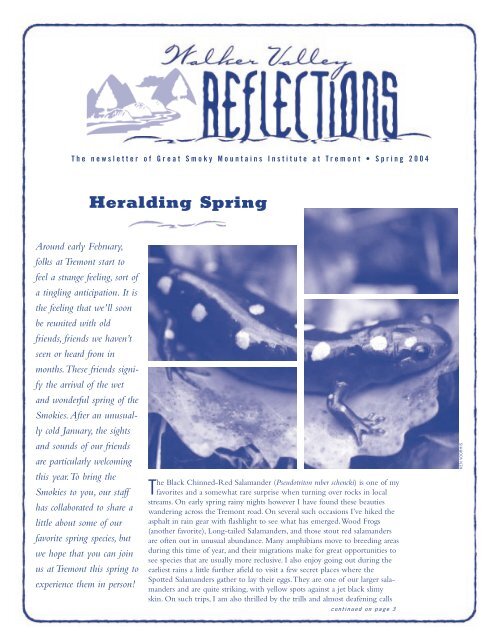


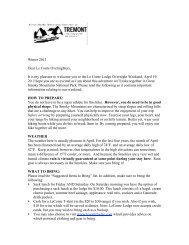
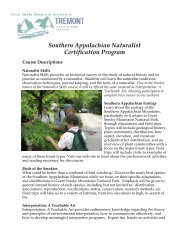


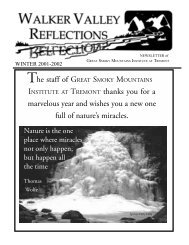
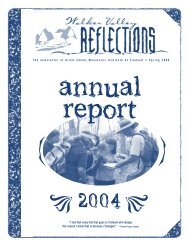
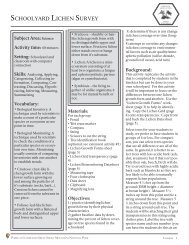
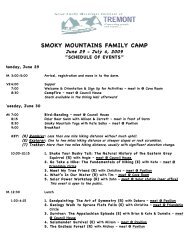
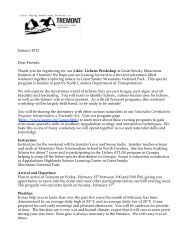
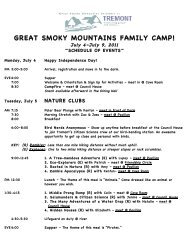
![Application [PDF] - Great Smoky Mountains Institute at Tremont](https://img.yumpu.com/22110613/1/190x245/application-pdf-great-smoky-mountains-institute-at-tremont.jpg?quality=85)
